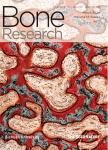Mice Deficient in NF-κB p50 and p52 or RANK Have Defective Growth Plate Formation and Post-natal Dwarfism
Mice Deficient in NF-κB p50 and p52 or RANK Have Defective Growth Plate Formation and Post-natal Dwarfism作者机构:Department of Pathology and Laboratory MedicineUniversity of Rochester Medical Center Department of BiochemistryRush University Medical Center
出 版 物:《Bone Research》 (骨研究(英文版))
年 卷 期:2013年第1卷第4期
页 面:336-345页
核心收录:
学科分类:0710[理学-生物学] 1002[医学-临床医学] 1001[医学-基础医学(可授医学、理学学位)] 100202[医学-儿科学] 10[医学]
基 金:supported by research grants from the National Institutes of Health PHS awards(AR48697 and AR63650 to LX AR055915 to DC and AR43510 and AR49305 to BFB)
主 题:NF-κB RANK growth plate chondrocytes dwarfism
摘 要:NF-κBp50/p52 double knockout (dKO) and RANK KO mice have no osteoclasts and develop severe osteopetrosis associated with dwarfism. In contrast, Op/Op mice, which form few osteoclasts, and Src KO mice, which have osteoclasts with defective resorptive function, are osteopetrotic, but they are not dwarfed. Here, we compared the morphologic features of long bones from p50/p52 dKO, RANK KO, Op/Op and Src KO mice to attempt to explain the differences in their long bone lengths. We found that growth plates in p50/p52 dKO and RANK KO mice are significantly thicker than those in WT mice due to a 2-3-fold increase in the hypertrophic chondrocyte zone associated with normal a proliferative chondrocyte zone. This growth plate abnormality disappears when animals become older, but their dwarfism persists. Op/Op or Src KO mice have relatively normal growth plate morphology. In-situ hybridization study of long bones from pS0/ p52 dKO mice showed marked thickening of the growth plate region containing type 10 collagen-expressing chondrocytes. Treatment of micro-mass chondrocyte cultures with RANKL did not affect expression levels of type 2 collagen and Sox9, markers for proliferative chondrocytes, but RANKL reduced the number of type 10 collagen-expressing hypertrophic chondrocytes. Thus, RANK/NF-κB signaling plays a regulatory role in post-natal endochondral ossification that maintains hypertrophic conversion and prevents dwarfism in normal mice.



